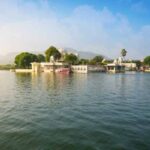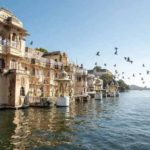Why Udaipur is called City of Lakes, often referred to as the “Lake City,” is a picturesque city in the Indian state of Rajasthan known for its stunning lakes, which form a significant part of its cultural and architectural identity.
The city’s moniker is primarily attributed to the presence of several artificial lakes that dot its landscape. The most famous among them is Lake Pichola, an expansive body of water created in the 14th century by Maharana Udai Singh II, the founder of Udaipur Tourism. The lake is flanked by lush hills, palaces, and temples, creating a breathtaking panorama. Another notable lake is Fateh Sagar, constructed in the 17th century by Maharana Fateh Singh. It is adorned with three islands, one of which houses the Udaipur Solar Observatory, providing an interesting blend of natural beauty and scientific importance.
The lakes were not only constructed for aesthetic reasons, but also served vital practical purposes. They were instrumental in providing water for irrigation, ensuring a steady supply of drinking water for the city, and controlling floods during the monsoon season. The ingenuity of the city’s forefathers in creating such water bodies in a region known for its arid climate is a testament to their engineering prowess.
Beyond their utilitarian functions, the lakes have become emblematic of Udaipur’s charm and allure. They have played a pivotal role in shaping the city’s tourism industry, attracting visitors from around the world who are captivated by the tranquil beauty and the reflections of the historic architecture mirrored in the water, Udaipur Attractions.
Overall, it is this unique interplay of nature and human intervention, combined with the practical benefits that the lakes bestow upon the city, that earns Udaipur its well-deserved title of the “Lake City.” The shimmering waters, set against the backdrop of majestic palaces and temples, create an ambiance of serenity and beauty that sets Udaipur apart as one of India’s most enchanting destinations.
There are around 10 lakes in the boundaries of Udaipur City that are interconnected to each other. Following are the Lakes in Udaipur:

Fateh Sagar Lake
Fateh Sagar Lake is one of the most captivating artificial lakes in Udaipur, Rajasthan, known for its scenic beauty and historical significance. Built in the 17th century by Maharana Fateh Singh, it is a marvel of engineering and a testament to the city’s architectural grandeur, Udaipur Tour Packages.
The lake is embellished with three picturesque islands – the largest being Nehru Park, where visitors can enjoy a boat ride amidst lush greenery. The second island, known as the Udaipur Solar Observatory, hosts an astronomical observatory that adds a touch of modern scientific intrigue to the lake’s cultural richness. The third island houses a water jet fountain, which is a popular attraction, especially during the annual World Music Festival.
Fateh Sagar Lake serves as a crucial source of water for the city and its surrounding areas, contributing significantly to Udaipur’s irrigation and drinking water needs. It also plays a vital role in controlling floods during the monsoon season.
Surrounded by hills and the majestic backdrop of Udaipur’s historic structures, Fateh Sagar Lake offers a tranquil escape from the bustle of city life. Its serene waters and the reflection of the surrounding landscape create a mesmerizing visual spectacle, making it a must-visit destination for tourists and locals alike, Why Udaipur is called City of Lakes.

Pichola Lake
Lake Pichola, situated in the heart of Udaipur, Rajasthan, is an enchanting artificial lake that epitomizes the city’s timeless beauty and architectural splendor. Constructed in the 14th century by Maharana Udai Singh II, the founder of Udaipur, it spans over an area of approximately 696 acres and reaches a depth of around 30 feet.
Surrounded by majestic hills, grand palaces, and ancient temples, Lake Pichola offers a breathtaking vista. Its centerpiece is the stunning Lake Palace, or Jag Niwas, a magnificent marble structure seemingly floating on the lake’s surface, now converted into a luxurious heritage hotel.
One of the distinctive features of Lake Pichola is its islands. Among these, Jag Mandir stands out, boasting an elegant marble structure and lush garden, providing a tranquil retreat amidst the shimmering waters.
Boat rides on Lake Pichola are a popular attraction, allowing visitors to soak in the serenity while beholding the architectural marvels that grace its shores. As evening descends, the lake’s waters mirror the illuminated palaces and temples, creating a surreal and magical atmosphere Why Udaipur is called City of Lakes.
Lake Pichola is not merely a body of water; it is an integral part of Udaipur’s identity, weaving together history, architecture, and natural beauty into a tapestry of wonder. It stands as a testament to the ingenuity and vision of those who built it, leaving an indelible mark on the landscape of this enchanting “City of Lakes.”

Badi Lake
Badi Lake, also known as Badi Ka Talab, is a picturesque artificial lake located on the outskirts of Udaipur, Rajasthan, India. Constructed in the 17th century by Maharana Raj Singh I, it was originally built to provide water for agricultural purposes in the surrounding region.
Covering an area of approximately 155 square kilometers, Badi Lake is one of the largest artificial lakes in Udaipur. It is surrounded by lush green hills, creating a serene and tranquil environment. The lake is renowned for its stunning views and peaceful atmosphere, making it a popular destination for both locals and tourists seeking respite from the hustle and bustle of city life.
One of the unique features of Badi Lake is its impressive stone masonry and picturesque chhatris (pavilions) that dot its banks. These architectural elements add to the scenic beauty of the lake and offer great spots for visitors to relax and enjoy the surroundings Why Udaipur is called City of Lakes.
In recent years, Badi Lake has gained popularity as a recreational spot. Visitors can engage in activities like boating or simply take leisurely strolls along its shores. The lake’s tranquility and natural beauty make it a perfect destination for those seeking a peaceful retreat while exploring the cultural and historical riches of Udaipur.
Dudh Talai Lake
Dudh Talai Lake is a small, picturesque lake located in the city of Udaipur, Rajasthan, India. Situated in close proximity to the famous Lake Pichola, Dudh Talai offers a serene and tranquil escape for both locals and tourists alike.
The lake is surrounded by lush green gardens, creating a peaceful ambiance for visitors to relax and unwind. It is a popular spot for leisurely walks, picnics, and enjoying the stunning views of the surrounding hills and historic cityscape.
One of the key attractions at Dudh Talai is the Dudh Talai Musical Garden. This beautifully landscaped garden features a musical fountain that comes to life in the evening with synchronized light and sound shows. The combination of water, music, and vibrant colors creates a mesmerizing experience for spectators Why Udaipur is called City of Lakes.
Dudh Talai also provides a panoramic view of the City Palace complex and the Jag Mandir Island, making it an excellent spot for photography enthusiasts. Additionally, there is a ropeway that connects Dudh Talai to the Karni Mata Temple, offering visitors a unique and scenic ride.
Overall, Dudh Talai Lake in Udaipur is a charming destination that allows visitors to immerse themselves in the natural beauty and cultural richness of this historic city. It provides a perfect blend of leisure, entertainment, and breathtaking views, making it a must-visit attraction in Udaipur.
Rajsamand Lake
Rajsamand Lake, also known as Rajsamudra Lake, is an impressive artificial lake located near Udaipur in the Indian state of Rajasthan. It was built by Maharana Raj Singh of Mewar in the 17th century, primarily as a reservoir to provide water for irrigation and to meet the drinking water needs of the region.
The lake spans over an area of approximately 1.75 square miles and is renowned for its architectural marvels. One of the most striking features is the exquisite marble pavilion or “chhatri” built in the center of the lake, known as the “Nauchowki,” which was constructed by Maharana Raj Singh.
Apart from its utilitarian purposes, Rajsamand Lake holds immense cultural significance. It has witnessed numerous historic events and ceremonies, making it an integral part of the region’s heritage. The embankments around the lake are adorned with beautifully carved stone guardrails and intricate statues depicting scenes from the Hindu epics Why Udaipur is called City of Lakes.
The serene waters of Rajsamand Lake, set amidst the picturesque Aravalli hills, provide a tranquil escape from the hustle and bustle of city life. It has also become a popular destination for birdwatchers and nature enthusiasts, attracting a variety of migratory birds.
Overall, Rajsamand Lake stands as a testament to the architectural and engineering prowess of the Mewar dynasty, and it continues to be a cherished gem in the cultural landscape of Udaipur.
Jaisamand Lake
Jaisamand Lake, also known as Dhebar Lake, is one of the largest artificial lakes in Asia, located near Udaipur in the Indian state of Rajasthan. Created in the 17th century by Maharana Jai Singh, the lake spans an impressive area of about 87 square kilometers, making it a significant hydrological and cultural landmark in the region.
The lake is surrounded by picturesque hills and lush forests, providing a stunning backdrop to its shimmering waters. It is dotted with several islands, one of which hosts the impressive Jaisamand Island Palace, an architectural marvel of the Mewar dynasty.
Jaisamand Lake holds particular historical and cultural importance for the local communities. The lake’s creation was not only an engineering feat but also a testament to the visionary leadership of the rulers of Mewar. The surrounding region is dotted with ancient temples, pavilions, and cenotaphs, further enriching its cultural significance Why Udaipur is called City of Lakes.
The lake serves as a reservoir for irrigation and drinking water for nearby villages, showcasing its practical utility alongside its aesthetic value. It also provides a habitat for a variety of wildlife, including migratory birds, adding to its ecological importance.
Overall, Jaisamand Lake stands as a testament to the rich history, culture, and natural beauty of the Udaipur region. Its expansive waters, combined with the surrounding architectural and natural wonders, make it a must-visit destination for travelers seeking a glimpse into the grandeur of Rajasthan’s heritage.
Udai Sagar Lake
Udai Sagar Lake is a historic artificial reservoir located in Udaipur, Rajasthan, India. Constructed by Maharana Udai Singh II, the founder of Udaipur, in the 16th century, it is one of the prominent lakes in the region Why Udaipur is called City of Lakes.
Spread over an area of about 10.5 square kilometers, Udai Sagar was created by building a dam on the Berach River. Its primary purpose was to provide a reliable source of water for the city and its surrounding areas, particularly during times of drought and scarcity.
The lake is flanked by picturesque hills and dotted with charming islands, some of which host ancient temples and structures. Its waters are a haven for a variety of aquatic life and bird species, making it a popular spot for nature enthusiasts and birdwatchers.
Udai Sagar Lake also holds historical significance. It played a crucial role in the development and sustenance of Udaipur, ensuring a stable water supply for the city’s inhabitants and agricultural needs. The lake, along with its surrounding landscapes, exudes a serene and tranquil atmosphere, attracting both locals and tourists seeking respite from the bustling city life.
Today, Udai Sagar Lake stands as a testament to the ingenuity of the city’s founders and continues to be an integral part of Udaipur’s cultural and natural heritage.
Roop Sagar Lake
Roop Sagar Lake is one of the lesser-known yet equally enchanting lakes in Udaipur, Rajasthan. Situated near the iconic Fateh Sagar Lake, it exudes a sense of tranquility and charm that captivates visitors.
Constructed in the 17th century by Maharana Ari Singh, Roop Sagar is smaller in comparison to its more famous counterparts, but it holds its own unique allure. The lake is flanked by ancient temples, historic havelis (traditional Indian mansions), and quaint residential areas, offering a glimpse into the rich cultural tapestry of Udaipur.
One of the most distinctive features of Roop Sagar is the ornate Gangaur Ghat, a beautifully adorned embankment that adds to the lake’s aesthetic appeal. The ghat is dedicated to the goddess Gauri, an incarnation of Parvati, and is an important site for local religious ceremonies and festivals.
Roop Sagar Lake, though less frequented by tourists, offers a serene escape from the bustling city life. Its reflective waters, especially during the early morning or at sunset, provide a serene backdrop for quiet contemplation or leisurely strolls along its shores Why Udaipur is called City of Lakes.
For those seeking a more intimate and off-the-beaten-path experience in Udaipur, Roop Sagar Lake provides a perfect destination, inviting visitors to soak in the city’s rich history and natural beauty in a more peaceful setting.
Goverdhan Sagar Lake
Goverdhan Sagar Lake, situated on the outskirts of Udaipur, Rajasthan, is one of the lesser-known yet equally enchanting bodies of water in the city. This artificial lake was constructed in the 17th century by Maharana Raj Singh to address the water scarcity issues faced by the region.
Spanning over an area of approximately 5.3 square kilometers, Goverdhan Sagar Lake provides a serene escape from the bustling city life. The lake is surrounded by picturesque hills and lush greenery, creating a tranquil atmosphere that attracts visitors seeking peace and relaxation Why Udaipur is called City of Lakes.
One of the distinctive features of this lake is its role in the city’s water conservation system. Goverdhan Sagar Lake is part of a network of lakes that work together to collect and store rainwater, which is crucial in maintaining a stable water supply for Udaipur and its surrounding areas, especially during dry spells.
Visitors can enjoy boat rides on the lake, taking in the scenic beauty and experiencing the calmness that pervades the area. The lake also offers a spectacular view of the Sajjangarh Palace, also known as the Monsoon Palace, perched on a nearby hill.
While not as famous as its counterparts like Lake Pichola and Fateh Sagar, Goverdhan Sagar Lake exemplifies Udaipur’s rich tradition of artificial lake construction and its commitment to sustainable water management, making it a hidden gem for those seeking a peaceful retreat amidst natural beauty.
Swaroop Sagar Lake
Swaroop Sagar Lake is one of the beautiful artificial lakes that graces the city of Udaipur in the Indian state of Rajasthan. It was constructed by Maharana Swaroop Singh, after whom the lake is named, in the 18th century. The lake is an extension of the famous Lake Pichola and is located in close proximity to the renowned Jagdish Temple.
This picturesque lake is surrounded by lush green gardens, creating a serene atmosphere that attracts both locals and tourists alike. The lake is dotted with small islands, some of which are home to historic structures and luxurious hotels. One such island houses the Udaipur Solar Observatory, which adds a scientific dimension to the lake’s appeal.
Visitors to Swaroop Sagar Lake can indulge in leisurely boat rides, allowing them to soak in the scenic beauty and take in the views of the surrounding architecture, including the City Palace and the Lake Palace. The lake also plays a practical role in the city’s water management system, contributing to irrigation and acting as a reservoir during the monsoon season Why Udaipur is called City of Lakes.
Swaroop Sagar Lake, with its tranquil waters and stunning backdrop, is a testament to the architectural and engineering prowess of the bygone era and continues to be a cherished jewel in the crown of Udaipur’s lakes.








